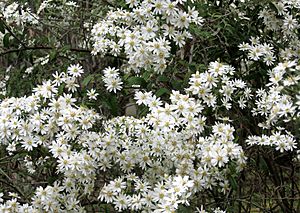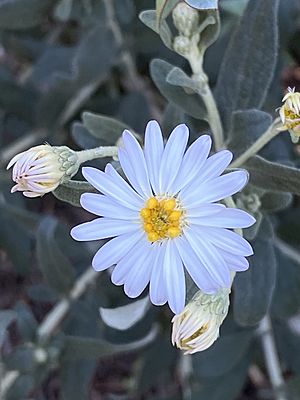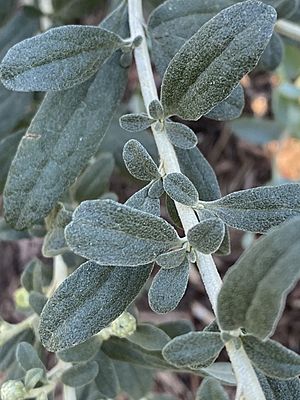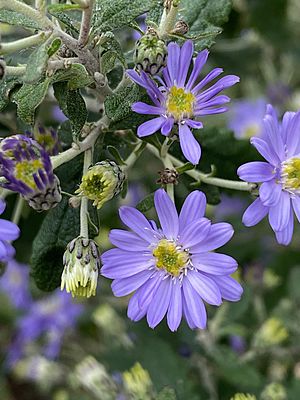Dusty Daisy-bush facts for kids
Quick facts for kids Dusty Daisy-bush |
|
|---|---|
 |
|
| Scientific classification | |
| Kingdom: | |
| (unranked): | |
| (unranked): | |
| (unranked): | |
| Order: | |
| Family: | |
| Tribe: |
Astereae
|
| Genus: |
Olearia
|
| Species: |
O. phlogopappa
|
| Binomial name | |
| Olearia phlogopappa (Labill.) DC.
|
|
| Synonyms | |
|
|
Olearia phlogopappa is a beautiful flowering plant often called the dusty daisy-bush or alpine daisy-bush. It belongs to the Asteraceae family, which includes daisies and sunflowers. You can find this plant growing in eastern New South Wales, Victoria, and Tasmania, Australia. It's a small shrub with grey-green leaves and pretty daisy-like flowers. These flowers can be white, pink, or even purple. They bloom from spring all the way through to late summer.
Contents
What it Looks Like
The dusty daisy-bush is a small shrub that stands upright. It usually grows between 0.3 m (0.98 ft) and 3 m (9.8 ft) tall. Its leaves are a greyish color.
Leaves
The leaves grow one after another along the stem. They can be narrow and egg-shaped or wider at the tip. They are usually about 8 mm (0.31 in) to 114 mm (4.5 in) long and 3 mm (0.12 in) to 23 mm (0.91 in) wide. Each leaf sits on a short stem. The top of the leaf is a dull grey-green. It can be smooth or have tiny star-shaped hairs. The underside of the leaf often looks whitish or yellowish. The edges of the leaves can be wavy, toothed, or have even slanting cuts.
Flowers
The flowers of the dusty daisy-bush come in different colors. White is the most common, but you can also see blue or pink ones. The flowers grow in bunches at the ends of the side branches. Each "daisy" flower is about 15 mm (0.59 in) to 25 mm (0.98 in) across.
Around the base of each flower, there are 4 to 5 bell-shaped or half-round bracts. These are like small leaves that protect the flower bud. They are covered with short, soft hairs. Each daisy flower usually has 10 to 14 "petals," which are actually called ray florets. These plants bloom in spring and early summer. After flowering, the plant produces a small fruit. This fruit is about 2 mm (0.079 in) to 3 mm (0.12 in) long and holds a single seed.
Plant Names and History
The scientific name for this plant, Olearia phlogopappa, was first officially written down in 1806. This was done by a scientist named Jacques Labillardière. He first called it Aster phlogopappus.
What the Name Means
The second part of the name, phlogopappa, comes from two Ancient Greek words. Phlogos means "flame," and pappos means "pappus". The pappus is a ring of hairs above the seed. This name refers to the flame-colored hairs that were seen on the plant when it was first described.
Different Types of Dusty Daisy-Bush
There are nine different types, or subspecies, of Olearia phlogopappa. These are slightly different versions of the plant that have adapted to various places. Some examples include:
- O. phlogopappa subsp. continentalis: This shrub can grow up to 2 m (6.6 ft) tall. It has green, egg-shaped leaves with uneven edges and star-shaped hairs. It flowers from October to December.
- O. phlogopappa subsp. flavescens: This type is an upright shrub that can reach 1.4 m (4.6 ft) high. Its leaves are thick and can be egg-shaped or narrow. It flowers from December to February.
- O. phlogopappa subsp. insularis: This shrub spreads out and can grow up to 1.5 m (4.9 ft) high. Its thick leaves can be oblong or egg-shaped. It flowers from October to December.
- O. phlogopappa subsp. phlogopappa: This is a small shrub that can be dense or open. It grows 1 m (3.3 ft) to 3 m (9.8 ft) high. Its grey-green leaves have toothed edges. White flowers appear in clusters, mainly from September to January.
- O. phlogopappa subsp. salicina: This is a tall, slender shrub that can grow up to 2 m (6.6 ft) high. Its leaves are long and narrow. When crushed, the leaves have a strong smell. It flowers from October to December.
- O. phlogopappa subsp. serrata: This small shrub grows up to 1 m (3.3 ft) high. Its leaves are egg-shaped with slanting, toothed edges. It flowers from November to January.
Where it Grows
Olearia phlogopappa is very common and can be found in many places, from the coast to the mountains. It grows in both dry and wet forests. You can find it across eastern New South Wales, Victoria, and Tasmania.
The Olearia genus, which this plant belongs to, has about 130 different species. Most of these are found in Australia, but some also grow in New Zealand and New Guinea.
- The continentalis subspecies grows in scattered spots in NSW and is common in Victoria. It likes moist or wet forests.
- The flavescens subspecies is found in NSW and is widespread in Victoria. It grows in high mountain areas, heathlands, and rocky places.
- The insularis subspecies grows in Victoria and Tasmania. It is often found in coastal heath or sand dunes.
- The phlogopappa subspecies grows in Victoria. It prefers moist or wet places that drain well.
- The salicina subspecies is found in specific areas of Victoria and Tasmania. It mostly grows in wet forests or dry woodlands.
- The serrata subspecies is found in Victoria and NSW. It grows on slopes and near the start of rivers, often in open heathlands close to Eucalyptus trees.
Growing This Plant
The dusty daisy-bush can handle some frost and dry periods. However, it grows best in moist soil that drains well and in a sunny spot. If it's in too much shade, it won't flower as much. You might need to trim it to keep it from getting too leggy. You can grow new plants from seeds or from cuttings taken from the tips of branches.
Popular Types to Grow
Many different types of dusty daisy-bush are sold for gardens. Some popular ones include:
- 'Comber's Blue'
- 'Comber's Mauve'
- 'Comber's Pink'
- 'Exbury White'
- 'Rosea'
- 'Sawtooth'
- 'Splendens Group'
- 'Tournaig Titch'
Related Plants
- Olearia brevipedunculata: This is another small shrub found in Victoria and parts of New South Wales. It is also sometimes called the dusty daisy-bush.
Images for kids





